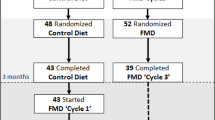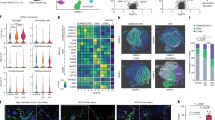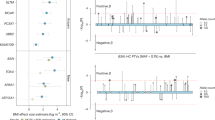Abstract
Alzheimer’s disease (AD) is the most common form of dementia without effective clinical treatment. Here, we show that intermittent fasting (IF) improves cognitive functions and AD-like pathology in a transgenic AD mouse model (5XFAD). IF alters gut microbial composition with a significant enrichment in probiotics such as Lactobacillus. The changes in the composition of the gut microbiota affect metabolic activities and metabolite production. Metabolomic profiling analysis of cecal contents revealed IF leads to a decreased carbohydrate metabolism (for example, glucose) and an increased abundance in amino acids (for example, sarcosine and dimethylglycine). Interestingly, we found that the administration of IF-elevated sarcosine or dimethylglycine mimics the protective effects of IF in 5XFAD mice, including the amelioration of cognitive decline, amyloid-β (Aβ) burden and glial overactivation. Our findings thus demonstrate an IF regimen is a potential approach to prevent AD progression, at least through the gut-microbiota-metabolites-brain axis, and constitutes an innovative AD therapeutic avenue.
This is a preview of subscription content, access via your institution
Access options
Access Nature and 54 other Nature Portfolio journals
Get Nature+, our best-value online-access subscription
$29.99 / 30 days
cancel any time
Subscribe to this journal
Receive 12 digital issues and online access to articles
$119.00 per year
only $9.92 per issue
Buy this article
- Purchase on Springer Link
- Instant access to full article PDF
Prices may be subject to local taxes which are calculated during checkout







Similar content being viewed by others
Data availability
16S rRNA sequence data have been deposited at NCBI Sequence Read Archive and are available under accession number: PRJNA872262. Metabolomics data are provided in Supplementary Table 1. Source data are provided within this paper. Any additional data generated and analyzed in this study are available from the corresponding authors upon reasonable request.
References
GBD 2019 Dementia Forecasting Collaborators. Estimation of the global prevalence of dementia in 2019 and forecasted prevalence in 2050: an analysis for the Global Burden of Disease Study 2019. Lancet Public Health 7, e105–e125 (2022).
Hardy, J. & Selkoe, D. J. The amyloid hypothesis of Alzheimer’s disease: progress and problems on the road to therapeutics. Science 297, 353–356 (2002).
Huang, Y. & Mucke, L. Alzheimer mechanisms and therapeutic strategies. Cell 148, 1204–1222 (2012).
Herrup, K. The case for rejecting the amyloid cascade hypothesis. Nat. Neurosci. 18, 794–799 (2015).
Doody, R. S. et al. Phase 3 trials of solanezumab for mild-to-moderate Alzheimer’s disease. New Engl. J. Med. 370, 311–321 (2014).
Salloway, S. et al. Two phase 3 trials of bapineuzumab in mild-to-moderate Alzheimer’s disease. New Engl. J. Med. 370, 322–333 (2014).
Morris, J. K., Honea, R. A., Vidoni, E. D., Swerdlow, R. H. & Burns, J. M. Is Alzheimer’s disease a systemic disease. Biochim. Biophys. Acta 1842, 1340–1349 (2014).
de Cabo, R. & Mattson, M. P. Effects of intermittent fasting on health, aging, and disease. New Engl. J. Med. 381, 2541–2551 (2019).
Ulgherait, M. et al. Circadian autophagy drives iTRF-mediated longevity. Nature 598, 353–358 (2021).
Vernieri, C. et al. Fasting-mimicking diet is safe and reshapes metabolism and antitumor immunity in patients with cancer. Cancer Discov. 12, 90–107 (2022).
Longo, V. D., Di Tano, M., Mattson, M. P. & Guidi, N. Intermittent and periodic fasting, longevity and disease. Nat. Aging 1, 47–59 (2021).
Zhou, Z. L. et al. Neuroprotection of fasting mimicking diet on MPTP-induced Parkinson’s disease mice via gut microbiota and metabolites. Neurotherapeutics 16, 741–760 (2019).
Ehrnhoefer, D. E. et al. Preventing mutant huntingtin proteolysis and intermittent fasting promote autophagy in models of Huntington disease. Acta Neuropathol. Commun. 6, 16 (2018).
Wang, H. B. et al. Time-restricted feeding improves circadian dysfunction as well as motor symptoms in the Q175 mouse model of Huntington’s disease. eNeuro 5, ENEURO.0431-17.2017 (2018).
Halagappa, V. K. et al. Intermittent fasting and caloric restriction ameliorate age-related behavioral deficits in the triple-transgenic mouse model of Alzheimer’s disease. Neurobiol. Dis. 26, 212–220 (2007).
Zhang, J. et al. Intermittent fasting protects against Alzheimer’s disease possible through restoring Aquaporin-4 polarity. Front. Mol. Neurosci. 10, 395 (2017).
Shin, B. K., Kang, S., Kim, D. S. & Park, S. Intermittent fasting protects against the deterioration of cognitive function, energy metabolism and dyslipidemia in Alzheimer’s disease-induced estrogen deficient rats. Exp. Biol. Med. 243, 334–343 (2018).
Liu, Y. et al. SIRT3 mediates hippocampal synaptic adaptations to intermittent fasting and ameliorates deficits in APP mutant mice. Nat. Commun. 10, 1886 (2019).
Jiang, C., Li, G., Huang, P., Liu, Z. & Zhao, B. The gut microbiota and Alzheimer’s disease. J. Alzheimers Dis. 58, 1–15 (2017).
Vogt, N. M. Gut microbiome alterations in Alzheimer’s disease. Sci. Rep. 7, 13537 (2017).
Zhuang, Z. Q. et al. Gut microbiota is altered in patients with Alzheimer’s disease. J. Alzheimers Dis. 63, 1337–1346 (2018).
Wang, X. et al. Sodium oligomannate therapeutically remodels gut microbiota and suppresses gut bacterial amino acids-shaped neuroinflammation to inhibit Alzheimer’s disease progression. Cell Res. 29, 787–803 (2019).
Minter, M. R. et al. Antibiotic-induced perturbations in gut microbial diversity influences neuro-inflammation and amyloidosis in a murine model of Alzheimer’s disease. Sci. Rep. 6, 30028 (2016).
Bonfili, L. et al. Microbiota modulation counteracts Alzheimer’s disease progression influencing neuronal proteolysis and gut hormones plasma levels. Sci. Rep. 7, 2426 (2017).
Sun, J. et al. Fecal microbiota transplantation alleviated Alzheimer’s disease-like pathogenesis in APP/PS1 transgenic mice. Transl. Psychiatry 9, 189 (2019).
Kim, M. S. et al. Transfer of a healthy microbiota reduces amyloid and tau pathology in an Alzheimer’s disease animal model. Gut 69, 283–294 (2020).
Li, G. et al. Intermittent fasting promotes white adipose browning and decreases obesity by shaping the gut microbiota. Cell Metab. 26, 672–685.e674 (2017).
Cignarella, F. et al. Intermittent fasting confers protection in CNS autoimmunity by altering the gut microbiota. Cell Metab. 27, 1222–1235.e1226 (2018).
Liu, Z. et al. Gut microbiota mediates intermittent-fasting alleviation of diabetes-induced cognitive impairment. Nat. Commun. 11, 855 (2020).
Heneka, M. T. et al. Neuroinflammation in Alzheimer’s disease. Lancet Neurol. 14, 388–405 (2015).
Johnson, S. C., Rabinovitch, P. S. & Kaeberlein, M. mTOR is a key modulator of ageing and age-related disease. Nature 493, 338–345 (2013).
Mu, Q., Tavella, V. J. & Luo, X. M. Role of Lactobacillus reuteri in human health and diseases. Front. Microbiol. 9, 757 (2018).
Aßhauer, K. P., Wemheuer, B., Daniel, R. & Meinicke, P. Tax4Fun: predicting functional profiles from metagenomic 16S rRNA data. Bioinformatics 31, 2882–2884 (2015).
Chan, M. H., Chung, S. S., Stoker, A. K., Markou, A. & Chen, H. H. Sarcosine attenuates toluene-induced motor incoordination, memory impairment, and hypothermia but not brain stimulation reward enhancement in mice. Toxicol. Appl. Pharmacol. 265, 158–165 (2012).
Hsieh, C. P., Chen, H., Chan, M. H., Chen, L. & Chen, H. H. N,N-dimethylglycine prevents toluene-induced impairment in recognition memory and synaptic plasticity in mice. Toxicology 446, 152613 (2020).
Wang, G. et al. Plasma metabolite profiles of Alzheimer’s disease and mild cognitive impairment. J. Proteome Res. 13, 2649–2658 (2014).
Horgusluoglu, E. et al. Integrative metabolomics-genomics approach reveals key metabolic pathways and regulators of Alzheimer’s disease. Alzheimers Dement. 18, 1260–1278 (2021).
Wei, M. et al. Fasting-mimicking diet and markers/risk factors for aging, diabetes, cancer, and cardiovascular disease. Sci. Transl. Med. 9, eaai8700 (2017).
Nasaruddin, M. L., Syed Abd Halim, S. A. & Kamaruzzaman, M. A. Studying the relationship of intermittent fasting and β-amyloid in animal model of Alzheimer’s disease: a scoping review. Nutrients 12, 3215 (2020).
Saeedi, B. J. et al. Gut-resident Lactobacilli activate hepatic Nrf2 and protect against oxidative liver injury. Cell Metab. 31, 956–968 (2020).
Panpetch, W. et al. Additional Candida albicans administration enhances the severity of dextran sulfate solution induced colitis mouse model through leaky gut-enhanced systemic inflammation and gut-dysbiosis but attenuated by Lactobacillus rhamnosus L34. Gut Microbes 11, 465–480 (2020).
Costanzo, M. et al. Krill oil, vitamin D and Lactobacillus reuteri cooperate to reduce gut inflammation. Benef. Microbes 9, 389–399 (2018).
Gupta, N., Ferreira, J., Hong, C. H. L. & Tan, K. S. Lactobacillus reuteri DSM 17938 and ATCC PTA 5289 ameliorates chemotherapy-induced oral mucositis. Sci. Rep. 10, 16189 (2020).
Tenorio-Jiménez, C. et al. Lactobacillus reuteri V3401 reduces inflammatory biomarkers and modifies the gastrointestinal microbiome in adults with metabolic syndrome: the PROSIR Study. Nutrients 11, 1761 (2019).
Wang, G. et al. Lactobacillus reuteri ameliorates intestinal inflammation and modulates gut microbiota and metabolic disorders in dextran sulfate sodium-induced colitis in mice. Nutrients 12, 2298 (2020).
Usami, M., Miyoshi, M. & Yamashita, H. Gut microbiota and host metabolism in liver cirrhosis. World J. Gastroenterol. 21, 11597–11608 (2015).
Lavelle, A. & Sokol, H. Gut microbiota-derived metabolites as key actors in inflammatory bowel disease. Nat. Rev. Gastroenterol. Hepatol. 17, 223–237 (2020).
Talbot, K. et al. Demonstrated brain insulin resistance in Alzheimer’s disease patients is associated with IGF-1 resistance, IRS-1 dysregulation, and cognitive decline. J. Clin. Invest. 122, 1316–1338 (2012).
An, Y. et al. Gut microbiota-derived metabolites as key actors in inflammatory bowel disease. Alzheimers Dement. 14, 318–329 (2018).
Fernando, W. et al. Sodium butyrate reduces brain amyloid-β Levels and improves cognitive memory performance in an alzheimer’s disease transgenic mouse model at an early disease stage. J. Alzheimers Dis. 74, 91–99 (2020).
Jiang, Y., Li, K., Li, X., Xu, L. & Yang, Z. Sodium butyrate ameliorates the impairment of synaptic plasticity by inhibiting the neuroinflammation in 5XFAD mice. Chem. Biol. Interact. 341, 109452 (2021).
Colombo, A. V. Microbiota-derived short chain fatty acids modulate microglia and promote Aβ plaque deposition. Elife 10, e59826 (2021).
Dias, G. P. et al. Intermittent fasting enhances long-term memory consolidation, adult hippocampal neurogenesis, and expression of longevity gene Klotho. Mol. Psychiatry 26, 6365–6379 (2021).
Park, S., Zhang, T., Wu, X. & Yi Qiu, J. Ketone production by ketogenic diet and by intermittent fasting has different effects on the gut microbiota and disease progression in an Alzheimer’s disease rat model. J. Clin. Biochem. Nutr. 67, 188–198 (2020).
Walters, R. O. et al. Sarcosine is uniquely modulated by aging and dietary restriction in rodents and humans. Cell Rep. 25, 663–676 (2018).
Lazic, D. et al. Every-other-day feeding exacerbates inflammation and neuronal deficits in 5XFAD mouse model of Alzheimer’s disease. Neurobiol. Dis. 136, 104745 (2020).
Pan, R. Y. et al. Sodium rutin ameliorates Alzheimer’s disease-like pathology by enhancing microglial amyloid-beta clearance. Sci. Adv. 5, eaau6328 (2019).
Pei, J. C. et al. Therapeutic potential and underlying mechanism of sarcosine (N-methylglycine) in N-methyl-D-aspartate (NMDA) receptor hypofunction models of schizophrenia. J. Psychopharmacol. 33, 1288–1302 (2019).
Pan, R. Y. et al. Positive feedback regulation of microglial glucose metabolism by histone H4 lysine 12 lactylation in Alzheimer’s disease. Cell Metab. 34, 634–648 (2022).
Chen, J., Zhang, J., Zhang, W. & Chen, Z. Sensitive determination of the potential biomarker sarcosine for prostate cancer by LC-MS with N,N’-dicyclohexylcarbodiimide derivatization. J. Sep. Sci. 37, 14–19 (2014).
Acknowledgements
This work was supported by the National Natural Science Foundation of China (grants 82230042, 81930029 and 81630026 to Z.Y.), the National Major Project of Support Program (grant 2019-JCJQ-ZD-195 to Z.Y.) and the China Postdoctoral Science Foundation (grant 2020M683748 to R.-Y.P.).
Author information
Authors and Affiliations
Contributions
Z.Y. conceived and directed the project. R.-Y.P. and J.Z. designed and performed the experiments, analyzed the data and wrote the manuscript. J.W. and Yang Liao provided assistance with animal behavioral tests. Y.W. performed electrophysiological recording. Z.L. provided assistance with the bioinformatic analysis of the gut microbiome. Yajin Liao, C.Z., Z.L., L.S. and J.Y. contributed to data analysis. All authors discussed and commented on the manuscript.
Corresponding authors
Ethics declarations
Competing interests
The authors declare no competing interests.
Peer review
Peer review information
Nature Aging thanks Mark Mattson, Yvonne Nolan, and the other, anonymous, reviewer(s) for their contribution to the peer review of this work.
Additional information
Publisher’s note Springer Nature remains neutral with regard to jurisdictional claims in published maps and institutional affiliations.
Extended data
Extended Data Fig. 1 IF reduces the expression levels of Aβ in 5XFAD mice.
Western blotting analysis of Aβ in hippocampal lysates from 5XFAD-AL and 5XFAD-IF mice (left panel), with quantification of Aβ levels (right panel, n = 4 mice per group). Data are represented as the mean ± SEM. **p < 0.01. Two-tailed unpaired Student’s t-test.
Extended Data Fig. 2 IF suppresses mTOR signaling and activates autophagy in 5XFAD mice.
a, Western blotting analysis of indicated proteins (or modifications) in the hippocampal lysates of WT-AL, 5XFAD-AL, and 5XFAD-IF mice. b, Quantification of indicated protein levels shown in a (n = 4 mice per group). Data are represented as the mean ± SEM. *p < 0.05 and **p < 0.01; N.S., not significant. One-way ANOVA, followed by Tukey’s multiple comparisons test.
Extended Data Fig. 3 IF leads to significant metabolic changes in gut microbiota.
a, Kyoto Encyclopedia of Genes and Genomes (KEGG) pathway analysis showing the significantly different biological processes of the gut microbiota. b, Heatmap showing the predicted functions of the gut microbiota involved in the indicated pathways among WT-AL, 5XFAD-AL, and 5XFAD-IF mice.
Extended Data Fig. 4 Effects of IF and ABX on body weight and food intake in 5XFAD mice.
a, Bacterial colony formation of the fecal homogenates from 5XFAD mice after 7 days of oral gavage with vehicle or ABX (left panel) and the bacterium were collected with PBS and the optical density (O.D.) was measure at 600 nm (right panel, n = 3 per group). b, The images of ceca collected from indicated group mice at 6-month-old (left panel), with quantification of the relative cecum volume (right panel, n = 4 per group). c, Body weight of indicated group mice monitoring every day during the experiments. d, Body weight of indicated group mice at the beginning and the end of the experiments. e and f, Food intake per two days (c) and cumulative food intake (d) of indicated group mice. The number of mice were: n = 12 mice for the WT-AL; n = 10 mice for the 5XFAD-AL group; n = 11 mice for the 5XFAD-IF and 5XFAD-IF + ABX groups. Data are represented as the mean ± SEM. **p < 0.01 and ***p < 0.001; N.S., not significant. Two-tailed unpaired Student’s t-test (a and b) or one-way ANOVA (d), followed by Tukey’s multiple comparisons test.
Extended Data Fig. 5 UPLC-MS analysis of Sar and DMG in the serum and brain of mice.
a and b, Sar and DMG levels in the serum and brain samples of WT-AL, 5XFAD-AL, and 5XFAD-IF mice (n = 3 mice per group). c and d, Sar and DMG levels in the serum and brain samples of mice 1 h post i.p. injected with saline, Sar or DMG (n = 3 mice per group). Data are represented as the mean ± SEM. *p < 0.05 and **p < 0.01. Two-tailed unpaired Student’s t-test (c and d) or one-way ANOVA (a and b), followed by Tukey’s multiple comparisons test.
Extended Data Fig. 6 Effects of Sar or DMG on body weight, food intake, and cognition in WT mice.
a, Schematic diagram showing the drug treatment strategy in WT mice. b, Body weight of indicated group mice was monitoring every day during the experiments. c and d, Every day food intake (c) and cumulative food intake (d) of indicated group mice. e, Distance travelled to the platform during the training period in the MWM test. f-i, Latency of first time to enter the target (f), target entries (g), time spent in target quadrant (h), and mean swimming speed in the probe trial of the MWM test (i). j, NOR test recognition index of mice. The number of mice were: n = 11 mice for the WT and WT + Sar groups; n = 9 mice for the WT + DMG group. Data are represented as the mean ± SEM. *p < 0.05, **p < 0.01, and ***p < 0.001; N.S., not significant. Two-tailed unpaired Student’s t-test (j) or one-way ANOVA (f-i), followed by Tukey’s multiple comparisons test.
Extended Data Fig. 7 Sar or DMG treatment reduces the expression levels of Aβ in 5XFAD mice.
Western blotting analysis of Aβ in hippocampal lysates from 5XFAD, 5XFAD + Sar, and 5XFAD + DMG mice (left panel), with quantification of Aβ levels (right panel, n = 4 mice per group). Data are represented as the mean ± SEM. *p < 0.05. Two-tailed unpaired Student’s t-test.
Supplementary information
Supplementary Table 1
Metabolomics raw data.
Source data
Source Data Fig. 1
Statistical Source Data.
Source Data Fig. 2
Statistical Source Data.
Source Data Fig. 2
Unprocessed western blots.
Source Data Fig. 4
Statistical Source Data.
Source Data Fig. 5
Statistical Source Data.
Source Data Fig. 6
Statistical Source Data.
Source Data Fig. 7
Statistical Source Data.
Source Data Extended Data Fig. 1
Statistical Source Data.
Source Data Extended Data Fig. 1
Unprocessed western blots.
Source Data Extended Data Fig. 2
Statistical Source Data.
Source Data Extended Data Fig. 2
Unprocessed western blots.
Source Data Extended Data Fig. 4
Statistical Source Data.
Source Data Extended Data Fig. 5
Statistical Source Data.
Source Data Extended Data Fig. 6
Statistical Source Data.
Source Data Extended Data Fig. 7
Statistical Source Data.
Source Data Extended Data Fig. 7
Unprocessed western blots.
Rights and permissions
Springer Nature or its licensor (e.g. a society or other partner) holds exclusive rights to this article under a publishing agreement with the author(s) or other rightsholder(s); author self-archiving of the accepted manuscript version of this article is solely governed by the terms of such publishing agreement and applicable law.
About this article
Cite this article
Pan, RY., Zhang, J., Wang, J. et al. Intermittent fasting protects against Alzheimer’s disease in mice by altering metabolism through remodeling of the gut microbiota. Nat Aging 2, 1024–1039 (2022). https://doi.org/10.1038/s43587-022-00311-y
Received:
Accepted:
Published:
Issue Date:
DOI: https://doi.org/10.1038/s43587-022-00311-y
This article is cited by
-
Microbiota–gut–brain axis and its therapeutic applications in neurodegenerative diseases
Signal Transduction and Targeted Therapy (2024)
-
Identifying disease-related microbes based on multi-scale variational graph autoencoder embedding Wasserstein distance
BMC Biology (2023)
-
Chiral nanoparticle-remodeled gut microbiota alleviates neurodegeneration via the gut–brain axis
Nature Aging (2023)
-
Intermittent fasting and Alzheimer's disease—Targeting ketone bodies as a potential strategy for brain energy rescue
Metabolic Brain Disease (2023)
-
Intermittent fasting to slow down Alzheimer’s disease
Nature Aging (2022)



